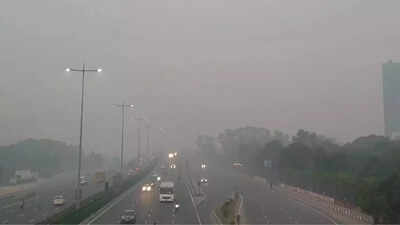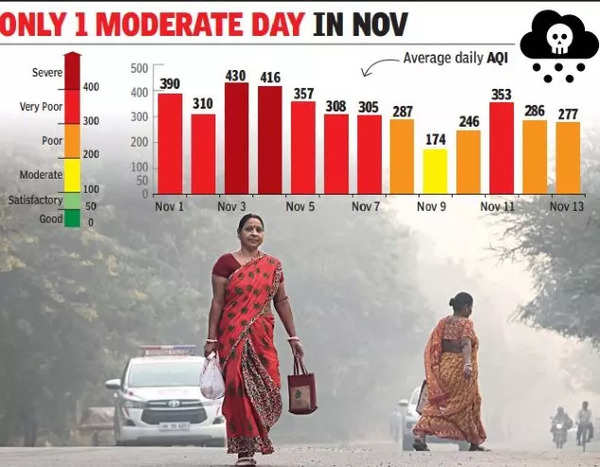- News
- City News
- gurgaon News
- Air still 'poor' in Gurugram, set to worsen by mid-week
Air still 'poor' in Gurugram, set to worsen by mid-week

The minimum temperature in Gurugram was 13.4 degrees Celsius on Sunday, and maximum was at 27.7 degrees Celsius
GURUGRAM: A steady breeze continued to steer away pollutants from NCR, marginally improving the city's air quality on Sunday to 282 from 286 the day before, though both readings still fall in the 'poor' category.
Meteorologists said this partial relief is due to 8kmph winds that are dispersing pollutants even though farm fires are blazing across Punjab, Haryana, UP and Rajasthan.

"At present the region is witnessing northwest winds which are bringing in cooler air, but we are yet to completely witness the winter cycle. The wind speed is still good (8 to 10 km/hr) which is dispersing the pollutants in the atmosphere," an official of the India Meteorological Department (IMD) said on Sunday.
Track the pollution level in your city
With air quality better than expected, neighbouring Delhi announced that the restrictions on movement of diesel cars that did not adhere to BS-VI emission standards will be lifted on Monday.
According to weather scientists, clearer than usual skies aren't here to stay.
The System of Air Quality and Weather Forecasting and Research (SAFAR) said on Sunday that surface winds between 10 and 20kmph will help scatter pollutants over the next two days. But a fall in temperature will again help accumulate pollutants in the atmosphere from Wednesday.
"The air quality index is likely to remain within 'poor' or 'upper end of poor' on November 14 and 15, but from November 16, due to temperature dips, AQI will again dip to a very poor category," an official of the Haryana State Pollution Control Board (HSPCB) said.
"Wind speed will slowly become calmer in the coming days, making dispersion of pollutants difficult," the IMD official added.
IMD has also forecast a dip in temperatures over the next few days. "It is expected that the temperature will fall by two to three degrees as the western disturbance is not over and cold wind from the mountains will gradually get its grip over the region. We are already witnessing colder nights. There is no likelihood of rain this week," the official said.
The minimum temperature in Gurugram was 13.4 degrees Celsius on Sunday, and maximum was at 27.7 degrees Celsius. The average 24-hour AQI for the day was 'poor' at Vikas Sadan (243), Gwalpahari (276) and Teri Gram (297) monitoring stations. At the Sector-51 station, it was 314 (very poor).
An analysis by SAFAR showed that stubble burning emissions contributed 24% to PM2.5 pollutants in Delhi-NCR.
Haryana has recorded 3,111 instances of farm fires between September 15 and November 13, of which the highest numbers were logged in Fatehabad (656), Kaithal (614), Jind (407), Kurukshetra (296), Karnal (286) and Ambala (212), according to satellite data collected by Nasa and collated by the Indian Agricultural Research Institute. In neighbouring Punjab, 45,319 active farm locations (AFLs) have been detected in this period. Other NCR cities also recorded 'poor' air days on Sunday. The average AQI was 272 in Faridabad, 230 in Ghaziabad and 231 in Noida. In Delhi, the air quality slipped to 'very poor', with the reading at 303.
Meteorologists said this partial relief is due to 8kmph winds that are dispersing pollutants even though farm fires are blazing across Punjab, Haryana, UP and Rajasthan.

"At present the region is witnessing northwest winds which are bringing in cooler air, but we are yet to completely witness the winter cycle. The wind speed is still good (8 to 10 km/hr) which is dispersing the pollutants in the atmosphere," an official of the India Meteorological Department (IMD) said on Sunday.
Track the pollution level in your city
With air quality better than expected, neighbouring Delhi announced that the restrictions on movement of diesel cars that did not adhere to BS-VI emission standards will be lifted on Monday.
According to weather scientists, clearer than usual skies aren't here to stay.
The System of Air Quality and Weather Forecasting and Research (SAFAR) said on Sunday that surface winds between 10 and 20kmph will help scatter pollutants over the next two days. But a fall in temperature will again help accumulate pollutants in the atmosphere from Wednesday.
"The air quality index is likely to remain within 'poor' or 'upper end of poor' on November 14 and 15, but from November 16, due to temperature dips, AQI will again dip to a very poor category," an official of the Haryana State Pollution Control Board (HSPCB) said.
"Wind speed will slowly become calmer in the coming days, making dispersion of pollutants difficult," the IMD official added.
IMD has also forecast a dip in temperatures over the next few days. "It is expected that the temperature will fall by two to three degrees as the western disturbance is not over and cold wind from the mountains will gradually get its grip over the region. We are already witnessing colder nights. There is no likelihood of rain this week," the official said.
The minimum temperature in Gurugram was 13.4 degrees Celsius on Sunday, and maximum was at 27.7 degrees Celsius. The average 24-hour AQI for the day was 'poor' at Vikas Sadan (243), Gwalpahari (276) and Teri Gram (297) monitoring stations. At the Sector-51 station, it was 314 (very poor).
An analysis by SAFAR showed that stubble burning emissions contributed 24% to PM2.5 pollutants in Delhi-NCR.
Haryana has recorded 3,111 instances of farm fires between September 15 and November 13, of which the highest numbers were logged in Fatehabad (656), Kaithal (614), Jind (407), Kurukshetra (296), Karnal (286) and Ambala (212), according to satellite data collected by Nasa and collated by the Indian Agricultural Research Institute. In neighbouring Punjab, 45,319 active farm locations (AFLs) have been detected in this period. Other NCR cities also recorded 'poor' air days on Sunday. The average AQI was 272 in Faridabad, 230 in Ghaziabad and 231 in Noida. In Delhi, the air quality slipped to 'very poor', with the reading at 303.
FOLLOW US ON SOCIAL MEDIA
FacebookTwitterInstagramKOO APPYOUTUBE
Start a Conversation
end of article









